The Fine Art of Food Prepping (Knife Terms Explained)
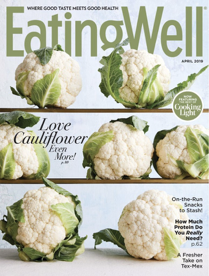
I discovered a stash of my Aunt Annie’s Eating Well magazines, and in a 1998 issue I found a very helpful article I thought you might appreciate. Here’s what I read about the fine art of food prepping: “For every time you’ve stood with your chef’s knife poised over zucchini, pondering the difference between recipe specifications like “finely chopped,” “minced,” or “diced,” take it from the chefs at the Culinary Institute—size DOES matter.”
This great article then went on to explain the difference between the specifications and how to go about achieving them. In case you’ve wondered about the exact meanings of these terms, here’s the scoop:
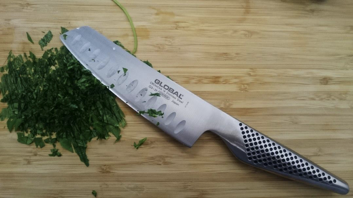
FINELY CHOPPED (this technique especially appropriate for herbs): Using the guiding hand to bunch stemmed leaves of your herbs, cut them into large pieces. Keeping guiding hand at knife tip, rock your knife from tip to heel until herbs are in about 1/8-inch (or less) pieces.
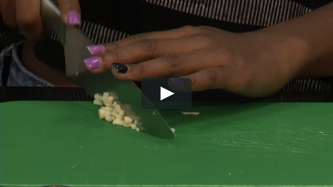
MINCED (this technique is particularly effective when working with fresh garlic ): Hold chef’s knife flat above garlic cloves. Press firmly on knife with heel of hand to smash and peel garlic. Keeping guiding hand at knife tip, rock the cutting edge of your knife from tip to heel until garlic is in about 1/16 pieces.
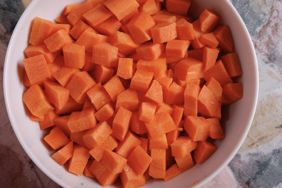
DICED VEGETABLES: For a medium dice, cut vegetable crosswise into ½-inch slices. Stack slices and cut into ½-inch strips. Cut strips crosswise into ½-inch cubes. For small dice, make 1/4-inch cuts; for large, make ¾-inch cuts. While the size of your dicing depends on personal taste, traditionally soups call for small to medium dices and stews call for medium to large dices.
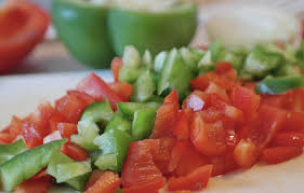
COARSELY CHOPPED VEGETABLES: Quarter or halve vegetables and cut them into 2- to 3-inch pieces. Keeping your guiding hand at knife tip, lift and lower knife heel until vegetables are in ½- to ¾-inch pieces.
The article concluded by saying that when a recipe tells us to cut an ingredient a certain way, there’s an important reason why. Different cuts will affect how quickly and evenly the pieces cook. And texture and flavor are also highly affected by how an ingredient is cut. For me, this advice means that I need to do better at following instructions. Often I’m tempted to take the lazy route and just quickly do my own thing; now I understand why some of my dishes don’t turn out all that great. Size DOES matter. Maybe you can relate?
Now, with all this said, here’s a traditional recipe from Eating Well that gives us a chance to try out their cutting tutoring:
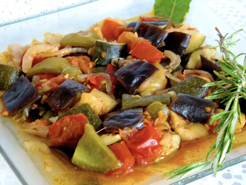
Ratatouille
Serving size: 1
Calories per serving: 508.667
2 tablespoons extra virgin olive oil
2 onions coarsely chopped
2 red and/or yellow red bell peppers seeded and cut into medium diced pieces
4 cloves garlic minced
1 1/2 teaspoons fennel crushed
1 medium eggplant cut into medium diced pieces
2 large zucchini cut into medium diced pieces
6 medium, ripe tomatoes cored and coarsely chopped
1/4 cup finely chopped, fresh basil
2 tablespoons finely chopped, fresh thyme
salt to taste
freshly ground black pepper to taste
2 tablespoons finely chopped, fresh parsley (preferably Italian flat-leaf)
Directions:
Add ½ tablespoon oil to pot. Add eggplant and cook, stirring frequently, until browned in places, 7-8 min. Transfer to bowl with vegetables.
Add remaining ½ tablespoon oil to pot. Add zucchini and cook, stirring frequently, until browned in places, about 5 minutes. Add tomatoes, basil, thyme and reserved vegetables to pot and bring to a simmer. Cover and transfer to the oven.
Bake ratatouille for 35-45 minutes, stirring occasionally, or until vegetables are tender. Season with salt and pepper. Serve hot and garnish with parsley before serving.
- www.topmags.com
- www.commons.wikimedia.org
- www.vimeo.com
- www.pixabay.com
- www.pxhere.com
 Alice Osborne
Alice Osborne
Weekly Newsletter Contributor since 2006
Email the author! alice@dvo.com
